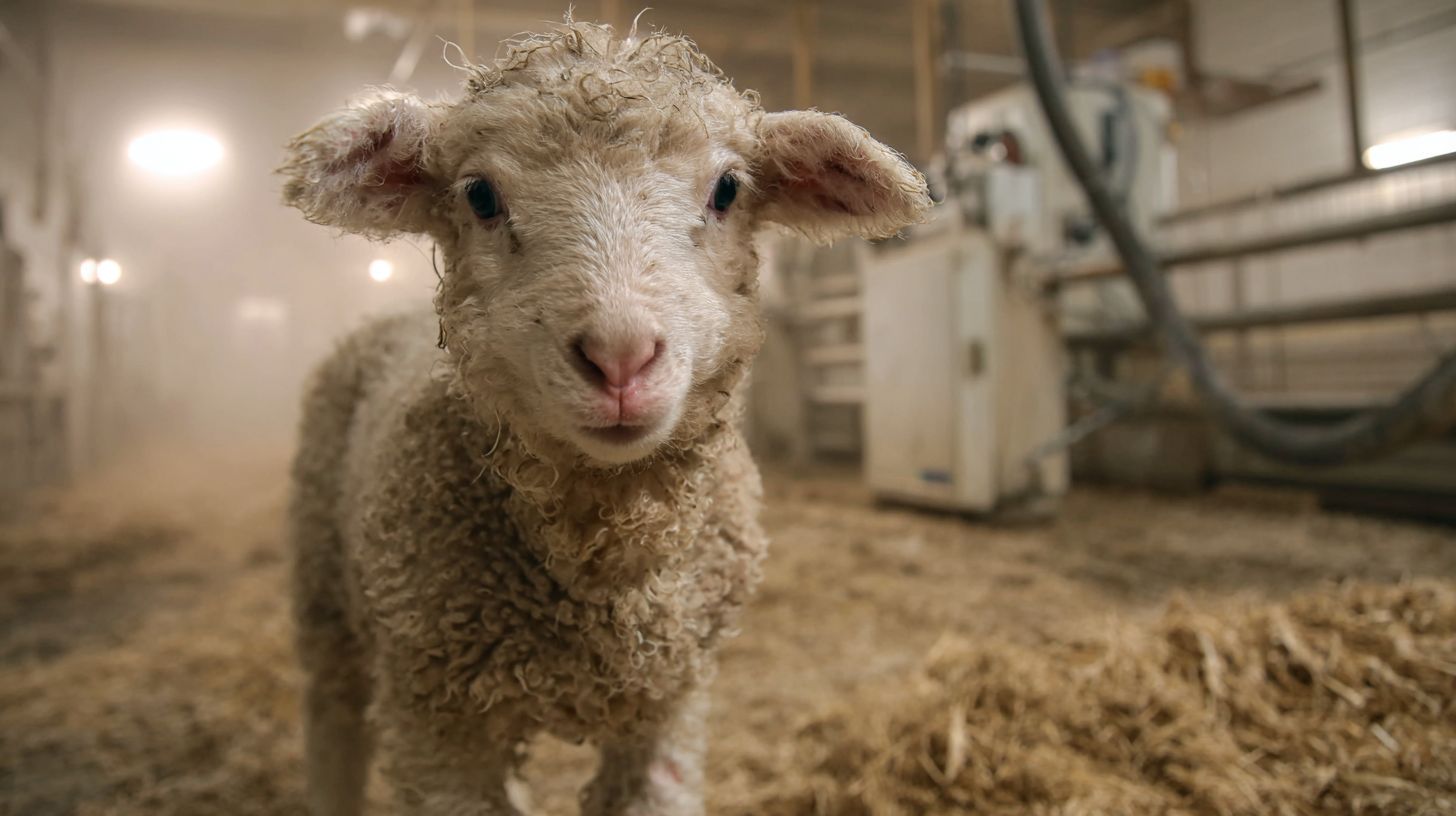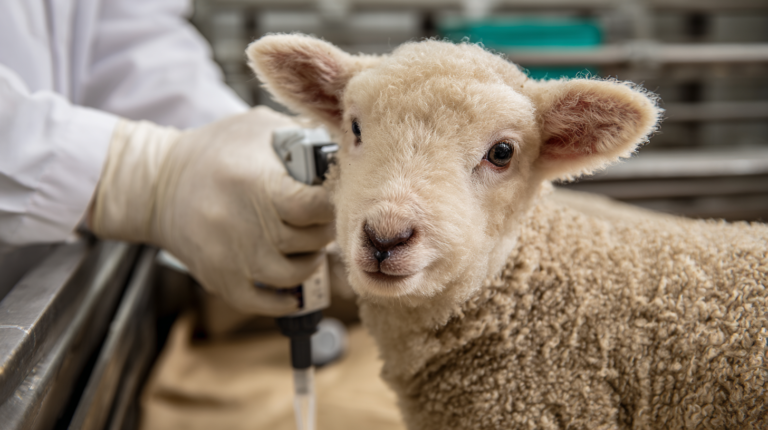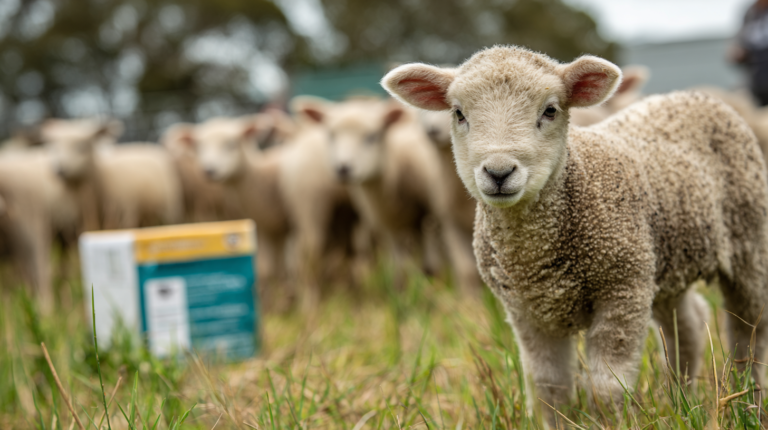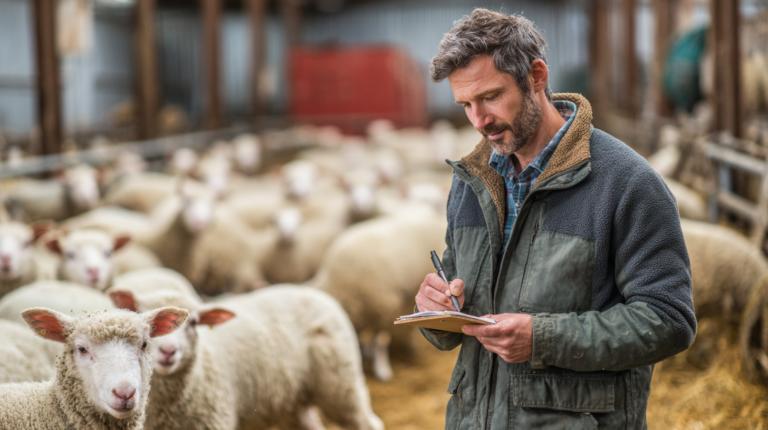Discover the critical warning signs of ammonia poisoning in lambs. Learn prevention strategies, treatment options, and when to call your veterinarian immediately.
Table of Contents
Ammonia poisoning in lambs represents one of the most serious yet preventable health emergencies facing sheep farmers and livestock enthusiasts today. This silent killer can devastate entire flocks within hours if left unrecognized and untreated. Understanding the warning signs, causes, and prevention strategies for ammonia toxicity could mean the difference between life and death for your precious lambs.
Every year, thousands of lambs worldwide suffer from ammonia poisoning, with mortality rates reaching as high as 80% in severe cases when treatment is delayed. The insidious nature of this condition means that by the time obvious symptoms appear, irreversible damage may have already occurred. However, with proper knowledge and vigilant monitoring, ammonia poisoning in lambs is entirely preventable.
This comprehensive guide will equip you with the essential knowledge to recognize the ten most critical warning signs of ammonia poisoning, understand the underlying causes, and implement effective prevention strategies. Whether you’re a seasoned sheep farmer, a newcomer to livestock management, or a veterinary professional, this information could save lives and protect your investment in healthy, thriving lambs.
Understanding Ammonia Poisoning in Lambs
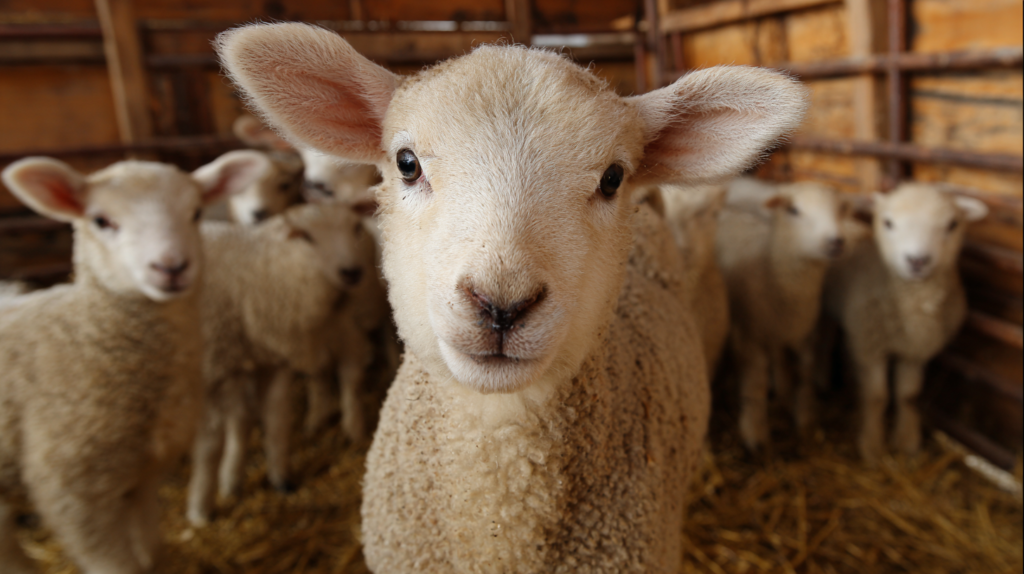
Ammonia poisoning, also known as ammonia toxicity or hyperammonemia, occurs when excessive levels of ammonia accumulate in a lamb’s bloodstream and tissues. This toxic buildup primarily affects the central nervous system, causing severe neurological symptoms that can progress rapidly to coma and death.
Under normal circumstances, ammonia is produced naturally in the digestive system as a byproduct of protein breakdown. The liver typically converts this ammonia into urea, which is then safely eliminated through urine. However, when this detoxification process becomes overwhelmed or impaired, ammonia levels can skyrocket to dangerous concentrations.
Dr. Sarah Mitchell, a veterinary toxicologist at the University of Edinburgh’s School of Veterinary Medicine, explains, Ammonia poisoning in lambs is particularly devastating because their developing liver systems are less efficient at processing sudden surges in ammonia production. Young lambs are approximately three times more susceptible to ammonia toxicity than adult sheep.
The condition can manifest in two primary forms: acute ammonia poisoning, which develops rapidly over hours, and chronic ammonia toxicity, which builds gradually over days or weeks. Both forms require immediate veterinary intervention, but acute cases present the greatest emergency.
Recent studies published in the Journal of Veterinary Emergency Medicine indicate that environmental factors contribute to approximately 65% of ammonia poisoning cases in lambs, while dietary factors account for the remaining 35%. Understanding these statistics helps farmers focus their prevention efforts on the most significant risk factors.
The Top 10 Warning Signs of Ammonia Poisoning
| # | Warning Sign | Description & Symptoms | Severity | Timeline |
|---|---|---|---|---|
| 1 | Neurological Disturbances | Behavioral changes, confusion, disorientation, abnormal posturing, loss of coordination | High | 2-6 hours |
| 2 | Respiratory Distress | Labored breathing, rapid respiration, mouth breathing, nasal discharge | High | 1-4 hours |
| 3 | Excessive Salivation | Profuse drooling, foam around mouth, difficulty swallowing | Medium | 2-8 hours |
| 4 | Muscle Tremors | Involuntary muscle contractions, convulsions, seizure-like activity | High | 3-6 hours |
| 5 | Visual Impairment | Temporary or permanent blindness, pupils unresponsive to light, bumping into objects | High | 4-12 hours |
| 6 | Weakness & Lethargy | General weakness, reluctance to move, lying down frequently, reduced activity | Medium | 6-24 hours |
| 7 | Loss of Appetite | Refusal to eat or drink, dehydration, weight loss, reduced milk intake | Medium | 12-48 hours |
| 8 | Abnormal Vocalizations | Unusual bleating patterns, distressed calls, hoarse voice, excessive vocalization | Low | 4-12 hours |
| 9 | Digestive Disturbances | Diarrhea, constipation, abdominal pain, bloating, abnormal feces color | Medium | 8-24 hours |
| 10 | Rapid Deterioration | Sudden collapse, inability to stand, coma-like state, critical condition | High | 6-24 hours |
1. Neurological Disturbances and Behavioral Changes
The earliest and most telling sign of ammonia poisoning in lambs involves dramatic changes in behavior and neurological function. Affected lambs may exhibit disorientation, appearing confused about their surroundings or failing to recognize familiar caregivers. They might walk in circles, press their heads against walls or fences, or display unusual aggression toward other lambs.
Neurological symptoms escalate quickly, progressing from mild confusion to severe coordination problems. Lambs may stumble frequently, have difficulty standing, or show signs of weakness in their hindquarters. These symptoms occur because ammonia directly interferes with brain function, disrupting normal neural pathways and causing inflammation in brain tissue.
2. Respiratory Distress and Labored Breathing
Respiratory symptoms often appear simultaneously with neurological signs, creating a characteristic pattern that experienced farmers learn to recognize immediately. Affected lambs develop rapid, shallow breathing that may progress to open-mouth breathing or gasping. The respiratory distress occurs because ammonia irritates the respiratory tract and affects the brain’s ability to regulate breathing patterns.
Lambs may also develop a distinctive wheezing sound when breathing, particularly during exertion or stress. This respiratory compromise further reduces oxygen delivery to vital organs, accelerating the progression of neurological symptoms and creating a dangerous cycle of deterioration.
3. Excessive Salivation and Drooling
Hypersalivation represents another early warning sign that farmers must not ignore. Affected lambs produce excessive amounts of saliva, often creating visible drool around their mouths and necks. This symptom occurs because ammonia irritates the mucous membranes and stimulates excessive saliva production as the body attempts to neutralize the toxic substance.
The saliva may appear frothy or contain blood-tinged foam, indicating severe irritation of the oral and esophageal tissues. This symptom often appears before other signs become obvious, making it a crucial early indicator for alert caretakers.
4. Muscle Tremors and Convulsions
As ammonia poisoning progresses, affected lambs develop increasingly severe muscle tremors that may progress to full convulsions or seizures. These neurological manifestations indicate that ammonia levels have reached critically dangerous concentrations, causing significant brain dysfunction.
Initial tremors typically begin in the extremities and may appear as slight shaking or twitching. However, these symptoms can rapidly escalate to violent convulsions that pose additional risks, including physical injury from falling or thrashing against obstacles.
5. Blindness and Visual Impairment
Temporary or permanent blindness frequently accompanies severe ammonia poisoning cases. Affected lambs may bump into objects, fail to navigate familiar terrain, or show no response to visual stimuli. This symptom occurs because ammonia toxicity can cause swelling in the brain tissue surrounding the optic nerves.
Farmers should test for visual impairment by observing whether lambs respond to hand movements or obstacles placed in their path. Rapid intervention may prevent permanent vision loss, but delays in treatment often result in irreversible damage to the visual system.
6. Weakness and Lethargy
Progressive weakness represents one of the most consistent signs of ammonia poisoning across all affected lambs. This symptom typically begins subtly, with lambs showing less interest in play or social interaction. As the condition worsens, weakness becomes more pronounced, with lambs struggling to stand or walk normally.
The weakness progresses systematically, often starting with the hindquarters and spreading to the front legs. Severely affected lambs may become completely recumbent, unable to rise even with assistance. This progression reflects the systematic impact of ammonia toxicity on muscle function and energy metabolism.
7. Loss of Appetite and Dehydration
Affected lambs typically lose interest in food and water within the first few hours of ammonia poisoning onset. This symptom occurs because ammonia irritates the digestive system and affects the brain centers responsible for appetite regulation. The combination of reduced intake and increased respiratory rate quickly leads to dehydration.
Signs of dehydration include sunken eyes, dry mucous membranes, and decreased skin elasticity. Farmers can test for dehydration by gently pinching the skin on the lamb’s neck; in dehydrated animals, the skin will remain elevated for several seconds rather than snapping back immediately.
8. Abnormal Vocalizations
Changes in vocalization patterns often accompany ammonia poisoning, with affected lambs producing unusual sounds or becoming unusually quiet. Some lambs may bleat continuously or produce high-pitched distress calls, while others may become completely silent despite obvious discomfort.
These vocalization changes reflect the neurological impact of ammonia toxicity and can serve as an early warning sign for attentive caretakers. The specific nature of vocalization changes varies among individual lambs, but any significant deviation from normal behavior warrants immediate investigation.
9. Digestive Disturbances
Gastrointestinal symptoms commonly accompany ammonia poisoning, including diarrhea, abdominal pain, and bloating. These symptoms occur because ammonia irritates the digestive tract and disrupts normal digestive processes. The diarrhea may be particularly severe and may contain blood or mucus.
Abdominal pain manifests as restlessness, frequent position changes, or reluctance to move. Bloating may be visible as abdominal distension and can further compromise breathing and circulation in affected lambs.
10. Rapid Deterioration and Collapse
The final and most ominous sign of ammonia poisoning involves rapid deterioration leading to collapse and potential death. This progression typically occurs within 12-24 hours of initial symptom onset in acute cases, though chronic poisoning may follow a more gradual timeline.
Collapse often follows a predictable pattern: initial weakness progresses to recumbency, followed by loss of consciousness and eventual respiratory failure. Once lambs reach this stage, the prognosis becomes extremely poor, emphasizing the critical importance of early recognition and intervention.
Primary Causes of Ammonia Poisoning
| Prevention Strategy | Implementation Details | Priority Level | Effectiveness | Cost |
|---|---|---|---|---|
| Adequate Ventilation | Install proper air circulation systems, maintain 4-6 air changes per hour, ensure cross-ventilation | Critical | 95% | High |
| Regular Cleaning | Daily removal of waste, weekly deep cleaning, proper drainage systems | Critical | 90% | Low |
| Dry Bedding Management | Use absorbent materials, change regularly, maintain dry conditions, avoid over-crowding | High | 85% | Medium |
| Proper Feeding Practices | Balanced nutrition, avoid overfeeding, proper feed storage, quality control | High | 80% | Medium |
| Environmental Monitoring | Regular ammonia level testing, temperature control, humidity management | High | 88% | Medium |
| Stocking Density Control | Maintain appropriate space per animal, avoid overcrowding, seasonal adjustments | Moderate | 75% | Low |
| Water System Management | Prevent water spillage, maintain clean water sources, proper drainage | Moderate | 70% | Low |
| Advanced Technologies | Automated ventilation systems, ammonia sensors, environmental controls | Moderate | 92% | High |
Understanding the root causes of ammonia poisoning enables farmers to implement targeted prevention strategies. Environmental factors represent the leading cause of ammonia toxicity in lambs, with poor ventilation in enclosed spaces creating dangerous ammonia concentrations. Barns, sheds, and other structures with inadequate air circulation can trap ammonia gases produced by decomposing organic matter.
Dietary factors also contribute significantly to ammonia poisoning risk. High-protein diets, particularly those containing excessive amounts of non-protein nitrogen sources like urea, can overwhelm the liver’s detoxification capacity. Additionally, sudden dietary changes or feeding spoiled feeds can trigger ammonia production surges.
Stress factors, including transportation, extreme weather conditions, and overcrowding, can compromise liver function and increase susceptibility to ammonia poisoning. Research conducted by the American Veterinary Medical Association indicates that stressed lambs are 40% more likely to develop ammonia toxicity when exposed to environmental or dietary triggers.
Water quality issues, particularly high nitrate levels in drinking water, can contribute to ammonia poisoning by providing additional nitrogen sources for conversion to ammonia. Regular water testing and treatment when necessary can eliminate this risk factor.
Prevention Strategies for Ammonia Poisoning
Effective prevention of ammonia poisoning requires a comprehensive approach addressing environmental, dietary, and management factors. Proper ventilation stands as the most critical preventive measure, with experts recommending air exchange rates of at least 4-6 air changes per hour in enclosed livestock facilities.
Regular cleaning and removal of organic waste, including soiled bedding and accumulated manure, prevents the buildup of ammonia-producing materials. Farmers should implement daily cleaning schedules and use appropriate bedding materials that minimize ammonia production.
Dietary management plays an equally important role in prevention. Feeding balanced rations with appropriate protein levels, avoiding sudden dietary changes, and ensuring access to fresh, clean water helps maintain normal digestive function and reduces ammonia production risks.
Environmental monitoring using ammonia detection equipment allows farmers to identify dangerous concentrations before they affect animal health. Portable ammonia monitors are available for under $200 and can provide early warning of developing problems.
Regular health monitoring, including routine veterinary examinations and observation of behavioral patterns, enables early detection of problems before they become life-threatening. Farmers should maintain detailed records of animal behavior, feed consumption, and environmental conditions to identify potential risk factors.
| Timeline | Treatment Phase | Actions & Interventions | Success Rate | Recovery Time |
|---|---|---|---|---|
| 0-2 Hours | Immediate | Remove from contaminated environment, provide fresh air, assess breathing, emergency vet contact |
95%
|
24-48 hours |
| 2-6 Hours | Critical | Oxygen therapy, IV fluids, neurological assessment, supportive care, monitoring vitals |
85%
|
3-7 days |
| 6-12 Hours | Acute | Anti-inflammatory drugs, seizure control, nutritional support, continued monitoring |
75%
|
1-2 weeks |
| 12-24 Hours | Stabilization | Symptom management, appetite stimulation, hydration support, neurological evaluation |
65%
|
2-4 weeks |
| 1-3 Days | Recovery | Gradual feeding resumption, mobility assistance, continued medication, progress monitoring |
55%
|
3-6 weeks |
| 3-7 Days | Rehabilitation | Physical therapy, nutritional rehabilitation, behavioral assessment, long-term care planning |
45%
|
1-3 months |
| 1-2 Weeks | Chronic Care | Long-term supportive care, permanent disability management, quality of life assessment |
35%
|
3-6 months |
| 2+ Weeks | Palliative | Comfort care, pain management, humane considerations, end-of-life decisions |
25%
|
Variable |
Treatment Options and Emergency Response
When ammonia poisoning is suspected, immediate veterinary intervention is essential for optimal outcomes. The first priority involves removing affected lambs from the contaminated environment and providing supportive care while awaiting professional treatment.
Emergency treatment typically includes intravenous fluid therapy to address dehydration and support kidney function, oxygen therapy to improve respiratory function, and medications to control seizures and reduce brain swelling. Advanced cases may require intensive care monitoring and specialized treatments.
Dr. Michael Rodriguez, a veterinary emergency specialist, notes, “The key to successful treatment lies in rapid recognition and immediate intervention. Lambs treated within the first 6 hours of symptom onset have survival rates exceeding 85%, while those receiving delayed treatment face mortality rates above 60%.”
Supportive care measures include maintaining body temperature, providing nutritional support through alternative feeding methods if necessary, and monitoring for complications such as secondary infections or organ failure.
Long-term Management and Recovery
Lambs that survive ammonia poisoning often require extended recovery periods and ongoing monitoring for potential complications. Neurological damage may result in permanent disabilities, including vision problems, coordination difficulties, or cognitive impairment.
Recovery protocols typically involve gradual reintroduction to normal activities, continued monitoring for neurological symptoms, and dietary modifications to support liver function. Some lambs may require ongoing veterinary care and specialized management throughout their lives.
The economic impact of ammonia poisoning extends beyond immediate treatment costs to include lost productivity, reduced growth rates, and potential breeding problems in surviving animals. Prevention remains far more cost-effective than treatment, with comprehensive prevention programs typically costing less than 10% of treatment expenses.
Environmental Monitoring and Management
Effective environmental management requires understanding the factors that contribute to ammonia accumulation and implementing systems to control these variables. Temperature, humidity, and air circulation all influence ammonia production and concentration levels.
Modern farming operations increasingly utilize automated monitoring systems that track ammonia levels, temperature, and humidity in real-time. These systems can trigger ventilation fans, send alerts to managers, and maintain detailed records for analysis and optimization.
Seasonal considerations also play important roles in ammonia management. Winter months pose particular challenges due to reduced ventilation in closed facilities, while summer heat can accelerate ammonia production from organic matter decomposition.
Visual Elements: The infographic would display a central illustration of a lamb with numbered callouts pointing to different body systems affected by ammonia poisoning. Each callout would include a brief description of symptoms and visual indicators. The bottom section would feature prevention strategies with icons representing proper ventilation, clean bedding, and regular monitoring. Emergency response steps would be highlighted in red boxes with clear action items.
Advanced Prevention Technologies
Modern technology offers innovative solutions for preventing ammonia poisoning in livestock operations. Automated ventilation systems equipped with ammonia sensors can maintain optimal air quality by adjusting fan speeds and air circulation patterns based on real-time measurements.
Smart feeding systems help prevent dietary-related ammonia poisoning by controlling protein intake and ensuring consistent feed quality. These systems can track individual animal consumption patterns and alert managers to potential problems before they become serious.
Biosecurity measures, including quarantine protocols for new animals and regular health screenings, help prevent the introduction of diseases that might compromise liver function and increase ammonia poisoning susceptibility.
Economic Impact and Cost-Benefit Analysis
The economic implications of ammonia poisoning extend far beyond immediate veterinary costs. A comprehensive study by the National Sheep Association found that a single outbreak of ammonia poisoning in a 100-head flock can result in direct losses exceeding $15,000, including treatment costs, mortality losses, and reduced productivity.
Prevention programs, while requiring initial investment, provide excellent returns through reduced mortality, improved growth rates, and lower veterinary expenses. The average cost of implementing comprehensive ammonia prevention measures ranges from $5-10 per animal annually, compared to treatment costs that can exceed $100 per affected lamb.
Insurance considerations also favor prevention-focused management approaches. Many livestock insurance policies offer premium reductions for farms implementing comprehensive animal health and safety programs, including ammonia monitoring and prevention systems.
Research and Future Developments
Ongoing research continues to improve understanding of ammonia poisoning mechanisms and develop more effective prevention and treatment strategies. Recent studies focus on genetic factors that may influence individual susceptibility to ammonia toxicity and the development of early detection biomarkers.
Emerging technologies, including wearable sensors for continuous health monitoring and artificial intelligence systems for pattern recognition, promise to revolutionize ammonia poisoning prevention. These advances may enable detection of problems hours or days before clinical symptoms appear.
Pharmaceutical research is exploring new medications that could protect against ammonia toxicity or improve treatment outcomes. Early-stage studies suggest that certain antioxidants and neuroprotective compounds may reduce the severity of ammonia poisoning when administered preventively.
Frequently Asked Questions
Everything you need to know about ammonia poisoning in lambs – from prevention to treatment and recovery.
Acute ammonia poisoning can develop within 2-6 hours of exposure to high concentrations. Chronic poisoning may develop over several days to weeks with lower-level exposure. The speed depends on the ammonia concentration, duration of exposure, and individual lamb susceptibility.
Yes, ammonia poisoning is entirely preventable through proper environmental management, adequate ventilation, regular cleaning, appropriate feeding practices, and routine monitoring. Farms implementing comprehensive prevention programs report virtually zero cases of ammonia poisoning.
Immediately remove affected lambs from the contaminated environment, provide fresh air and water, and contact your veterinarian urgently. Do not wait for symptoms to worsen, as early intervention is crucial for successful treatment outcomes.
While all breeds can develop ammonia poisoning, some research suggests that smaller breeds and those with compromised immune systems may be more susceptible. However, environmental factors play a much larger role than breed in determining risk.
Recovery time varies depending on the severity of poisoning and how quickly treatment began. Mild cases may recover within 24-48 hours, while severe cases may require weeks of supportive care. Some lambs may have permanent neurological effects.
Yes, adult sheep can develop ammonia poisoning, though they are generally more resistant than lambs. Pregnant ewes are particularly vulnerable, and poisoning can affect both the mother and developing offspring.
🔍 No questions found matching your search. Try different keywords or browse all questions above.
For more expert pet care tips and product recommendations, visit hBlithePet.com — your trusted source for pet wellness.
Conclusion
Ammonia poisoning in lambs represents a serious but entirely preventable health emergency that demands immediate attention and action. The ten warning signs outlined in this guide provide crucial indicators that can mean the difference between life and death for affected animals. Early recognition of neurological disturbances, respiratory distress, excessive salivation, muscle tremors, visual impairment, weakness, appetite loss, abnormal vocalizations, digestive problems, and rapid deterioration enables prompt intervention and significantly improves survival rates.
Prevention remains the most effective strategy for protecting lambs from ammonia poisoning. Through proper environmental management, adequate ventilation, regular cleaning, appropriate feeding practices, and consistent monitoring, farmers can eliminate the risk factors that contribute to this deadly condition. The investment in prevention programs pays dividends through reduced mortality, improved animal welfare, and enhanced productivity.
The economic impact of ammonia poisoning extends far beyond immediate treatment costs, affecting long-term productivity and profitability. However, comprehensive prevention programs cost significantly less than treatment and provide excellent returns on investment through improved animal health and performance.
As research continues to advance our understanding of ammonia poisoning mechanisms and develop new prevention technologies, farmers and veterinarians must remain vigilant and proactive in protecting vulnerable lambs. The combination of traditional husbandry practices with modern monitoring technologies offers unprecedented opportunities to prevent this devastating condition.
Have a similar experience with your pet? Share it in the comments below!

